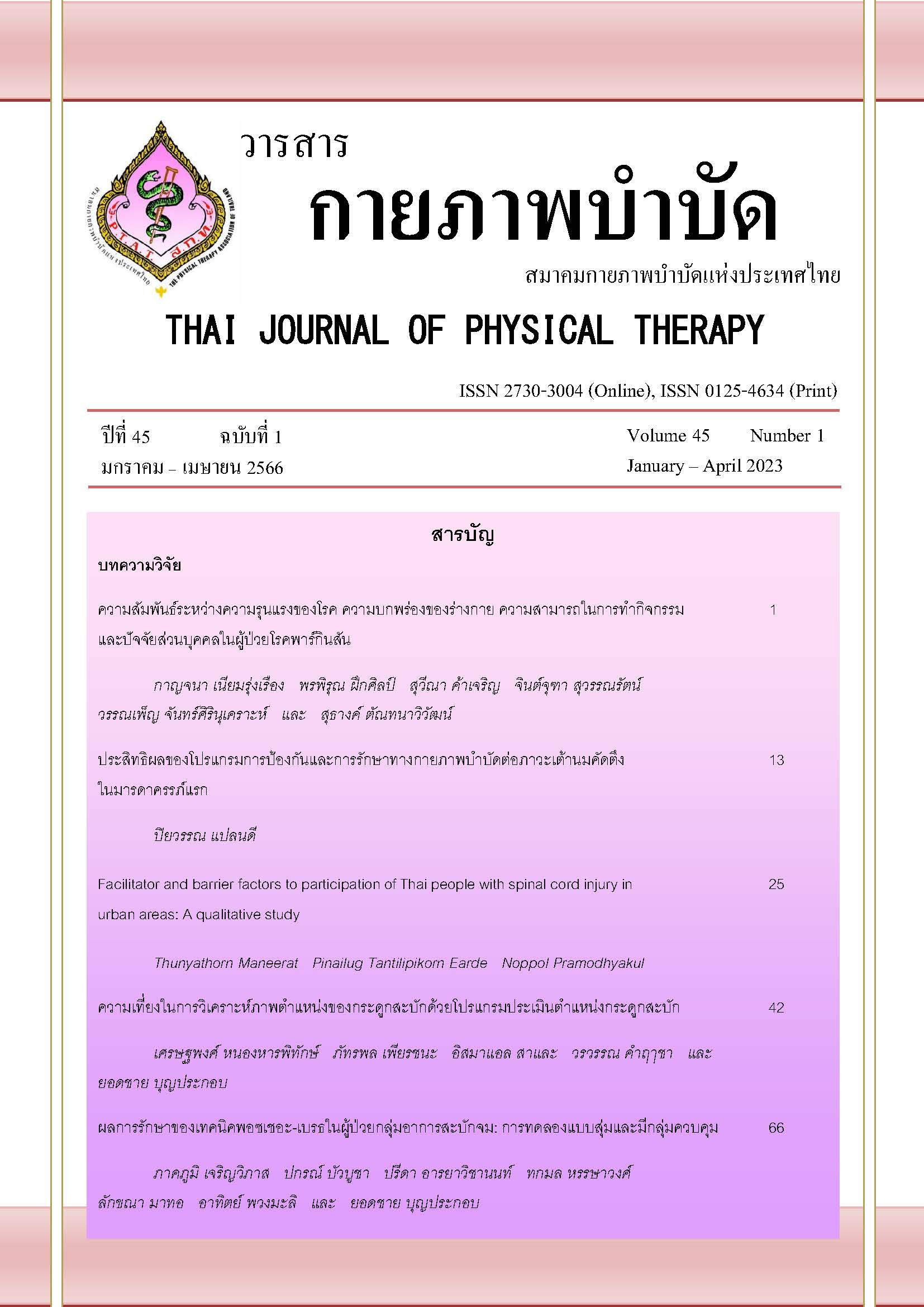Facilitator and barrier factors to participation of Thai people with spinal cord injury in urban areas: A qualitative study
Main Article Content
บทคัดย่อ
ที่มาและความสำคัญ: ความบกพร่องด้านร่างกายของผู้ป่วยบาดเจ็บไขสันหลัง อาจมีข้อจำกัดในกิจวัตรประจำวันและการมีส่วนร่วม ซึ่งการมีส่วนร่วมที่ลดลงสามารถนำไปสู่การมีคุณภาพชีวิตที่ลดลงและเกิดปัญหาทางสภาพจิตใจ
วัตถุประสงค์: ศึกษาปัจจัยส่งเสริมและอุปสรรคต่อการมีส่วนร่วมของผู้ป่วยบาดเจ็บไขสันหลัง
วิธีการวิจัย: สัมภาษณ์ผู้ป่วยบาดเจ็บไขสันหลัง ในเขตกรุงเทพมหานครและปริมณฑล จำนวน 8 คน ที่มีประสบการณ์การใช้รถเข็นนั่งในการทำกิจกรรมอย่างน้อย 6 เดือน
ผลการวิจัย: ผู้ป่วยบาดเจ็บไขสันหลัง รายงานปัจจัยส่งเสริม 6 ปัจจัย คือ ความคิดในการใช้ชีวิตอย่างอิสระ การสนับสนุนจากครอบครัว สภาพแวดล้อมทางกายภาพและรถเข็นนั่งที่เหมาะสม การทำกายภาพบำบัดและกิจกรรมบำบัด การสนับสนุนจากผู้อื่นและกิจกรรมนันทนาการและการกีฬา ส่วนปัจจัยอุปสรรค มี 5 ปัจจัย คือ สภาพแวดล้อมทางกายภาพและรถเข็นนั่งที่ไม่เหมาะสม ความบกพร่องของการทำงานของร่างกาย ทัศนคติส่วนบุคคลเชิงลบ สภาพแวดล้อมทางธรรมชาติ และความไม่สะดวกของการขนส่งสาธารณะ
สรุปผล: สภาพแวดล้อมทางกายภาพเป็นปัจจัยส่งเสริมและอุปสรรคต่อการทำกิจกรรมภายในบ้านสำหรับผู้ป่วยบาดเจ็บไขสันหลัง การสนับสนุนของครอบครัวและบุคคลอื่น โปรแกรมการฟื้นฟู กิจกรรมนันทนาการและกีฬา เป็นปัจจัยส่งเสริม ส่วนสภาพแวดล้อมทางธรรมชาติ ความไม่สะดวกของระบบขนส่ง ความบกพร่องทางร่างกาย และทัศนคติส่วนบุคคลเชิงลบ เป็นปัจจัยขัดขวาง ดังนั้นบุคลากรวิชาชีพ ควรพิจารณาปัจจัยดังกล่าว เพื่อส่งเสริมการมีส่วนร่วมสำหรับผู้ป่วยบาดเจ็บไขสันหลัง
Article Details

อนุญาตภายใต้เงื่อนไข Creative Commons Attribution-NonCommercial-NoDerivatives 4.0 International License.
เอกสารอ้างอิง
Kovindha A. People with Spinal Cord Injury in Thailand. Am J Phys Med Rehabil. 2017; 96(2 Suppl 1): S120-3.
Cobb JE, Leblond J, Dumont FS, Noreau L. Perceived influence of intrinsic/extrinsic factors on participation in life activities after spinal cord injury. Disabil Health J. 2018; 11(4): 583-90.
Piskur B, Daniels R, Jongmans MJ, Ketelaar M, Smeets RJ, Norton M, Beurskens AJ. Participation and social participation: are they distinct concepts?. Clin Rehabil. 2014; 28(3): 211-20.
Rauch A, Fekete C, Cieza A, Geyh S, Meyer T. Participation in physical activity in persons with spinal cord injury: A comprehensive perspective and insights into gender differences. Disabil Health J. 2013; 6(3): 165-76.
Wanchai A, Phrompayak D. A systematic review of factors influencing social participation of older adults. PRIJNR. 2019; 23(2): 131-41.
Magasi SR, Heinemann AW, Whiteneck GG. Quality of Life/Participation C. Participation following traumatic spinal cord injury: An evidence-based review for research. J Spinal Cord Med. 2008; 31(2): 145-56.
Fekete C, Brinkhof MW, Tough H, Siegrist J. Longitudinal study of social participation and well-being among persons with spinal cord injury and their partners (pro-WELL). BMJ Open. 2017; 7: e011597.
Fuseini A, Aniteye P, Alhassan A. Beyond the Diagnosis: Lived experiences of persons with spinal cord injury in a selected town in Ghana. Neurol Res Int. 2019; 2019: 9695740.
Kennedy P, Lude P, Taylor N. Quality of life, social participation, appraisals and coping post spinal cord injury: A review of four community samples. Spinal Cord. 2006; 44(2): 95-105.
Ferdiana A, Post MWM, Bultmann U, van der Klink, JJL. Barriers and facilitators for work and social participation among individuals with spinal cord injury in Indonesia. Spinal Cord. 2021; 59(10): 1079-87.
Carr JJ, Kendall MB, Amsters DI, Pershouse KJ, Kuipers P, Buettner P, et al. Community participation for individuals with spinal cord injury living in Queensland, Australia. Spinal Cord. 2017; 55(2): 192-7.
Barclay L, McDonald R, Lentin P, Bourke-Taylor H. Facilitators and barriers to social and community participation following spinal cord injury. Aust Occup Ther J. 2016; 63(1): 19-28.
Barclay L, McDonald R, Lentin P. Social and community participation following spinal cord injury: A critical review. Int J Rehabil Res. 2015; 38(1): 1-19.
Barclay L, Lentin P, McDonald R, Bourke-Taylor H. Understanding the factors that influence social and community participation as perceived by people with non-traumatic spinal cord injury. BJOT. 2017; 80(10): 577-86.
Hill J, Balbale S, Lones K, LaVela S. Starting a new conversation: Engaging veterans with spinal cord injury in discussions of what function means to them, the barriers/facilitators they encounter, and the adaptations they use to optimize function. Disabil Health J. 2017; 10(1): 114-22.
Suttiwong J, Vongsirinavarat M, Chaiyawat P, Vachalathiti R. Predicting community participation after spinal cord injury in Thailand. J Rehabil Med. 2015; 47(4): 325-9.
Nilchaikovit TL, Phisansuthideth U. Development of Thai version of Hospital Anxiety and Depression Scale in cancer patients. J Psychiatr Assoc Thailand. 1996; 41(1): 18-30.
Graneheim UH, Lundman B. Qualitative content analysis in nursing research: Concepts, procedures and measures to achieve trustworthiness. Nurse Educ Today. 2004; 24(2): 105-12.
Guest G, Namey E, Chen M. A simple method to assess and report thematic saturation in qualitative research. PLoS One. 2020; 15(5): e0232076.
Geyh S, Nick E, Stirnimann D, Ehrat S, Michel F, Peter C, et al. Self-efficacy and self-esteem as predictors of participation in spinal cord injury--an ICF-based study. Spinal Cord. 2012; 50(9): 699-706.
Chayapong J. Independent Living: A case study of mobility disabled people driving independently in Bangkok. Academic Services Journal. 2013; 24(4): 51-64.
Song HY. Modeling social reintegration in persons with spinal cord injury. Disabil Rehabil. 2005; 27(3): 131-41.
Peek C, Im-em W, Tangthanaseth R. The state of Thailand’s population 2015 “features of Thai families in the era of low fertilityand longevity”. Bangkok: United Nations Population Fund; 2016. (in Thai).
Rousseau-Harrison K, Rochette A, Routhier F, Dessureault D, Thibault F, Cote O. Impact of wheelchair acquisition on social participation. Disabil Rehabil Assist Technol. 2009; 4(5): 344-52.
Walia P, Kaur J. Development and validation of Incontinence - Activity Participation Scale for spinal cord injury. Indian J Urol. 2017; 33(2): 159-64.
Sadrossadat S, Sadrossadat L. The role of self-esteem on vocational rehabilitation of people with spinal cord injury. Iran Rehabil J. 2007; 5(5&6): 56-9.
Hosseini SM, Oyster ML, Kirby RL, Harrington AL, Boninger ML. Manual wheelchair skills capacity predicts quality of life and community integration in persons with spinal cord injury. Arch Phys Med Rehabil. 2012; 93(12): 2237-43.
Ghavarskhar F MH, Gharibi F, Sertyesilisik B. . A systematic review to compare residential care facilities for older people in developed countries: Practical implementations for Iran. Cogent Soc Sci. 2018; 4(1): 1-21.
Royal Thai Government Gazette. Persons with disabilities empowerment act, B.E. 2550 (2007). 2007; 61(12): 690-706.
Babamohamadi H, Negarandeh R, Dehghan-Nayeri N. Barriers to and facilitators of coping with spinal cord injury for Iranian patients: A qualitative study. Nurs Health Sci. 2011; 13(2): 207-15.
Kuptniratsaikul V, Kaewnaree S, Leurcharusamee A, Chavasiri C. Vocational and avocational activities after traumatic spinal injury. Siriraj Hosp. 1999; 51: 77-85.
Earde PT, Rodpradit P, Seanjumla P. Facilitators and barriers to performing activities and participation in children with cerebral palsy: Caregivers' perspective. Pediatr Phys Ther. 2018; 30(1): 27-32.


